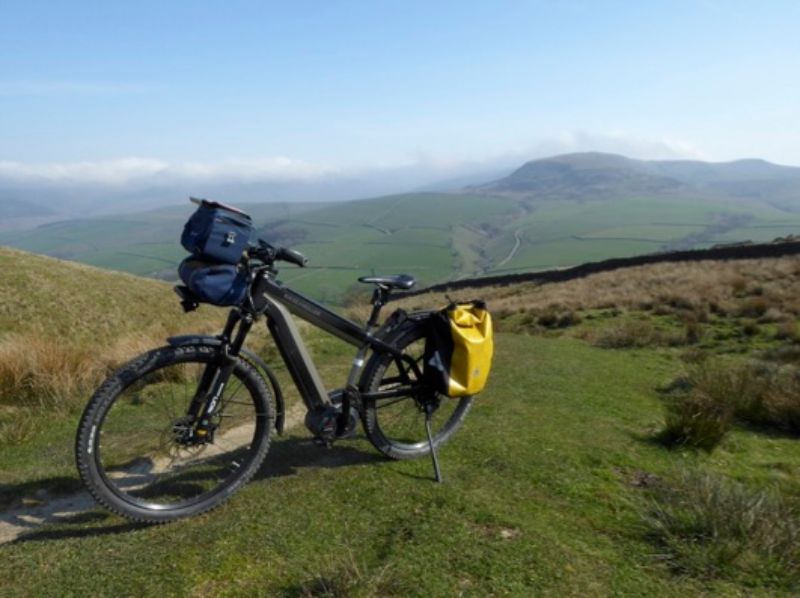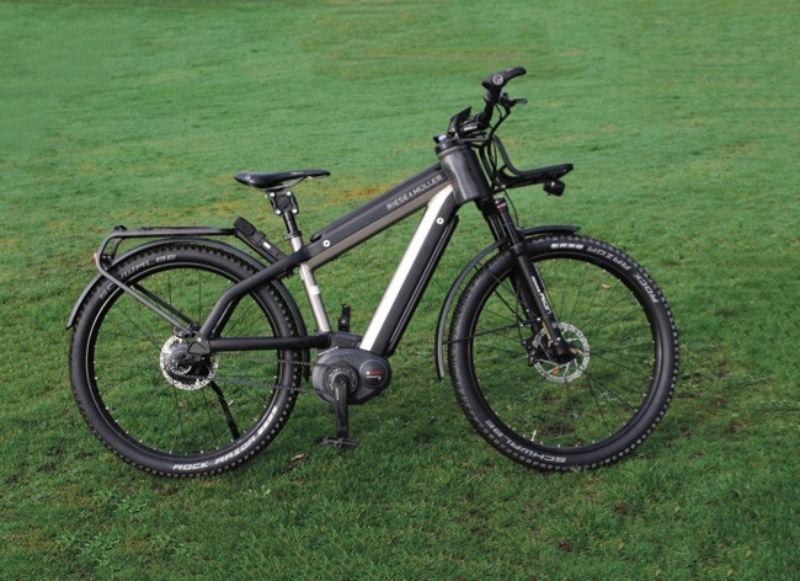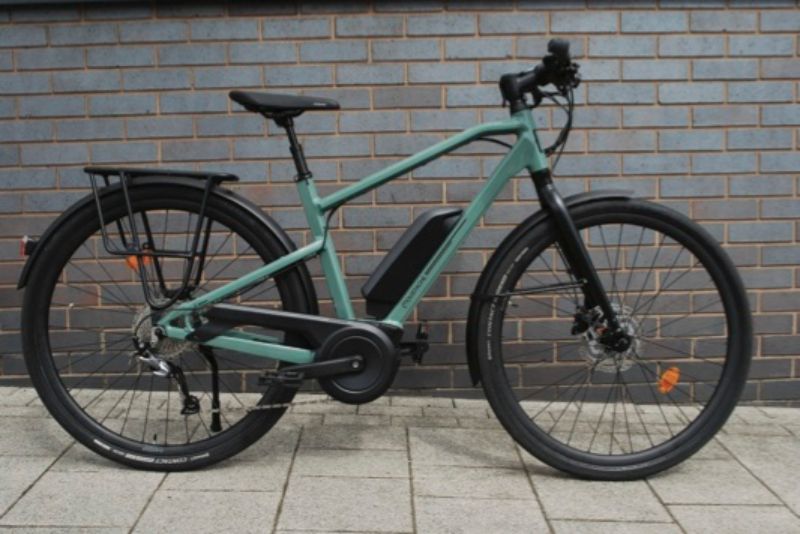Caravan advice: How to choose an e-bike
You’ve decided you like the sound of an e-bike.
But, where do you start?
How do you know which e-bike to choose to take on your caravan holidays?
Read our tips on how to choose an e-bike.
Plus, we test two of the latest e-bikes to see what range they can actually get in the real world and offer tips for getting maximum range.
Words by Richard Peace

The advert for the electric bike you fancy advertises it as having a range ‘up to’ a certain limit. But how do you know you can achieve that range?
Of course, until you try any e-bike out in the real world — with your body weight, your style of riding and over the terrain you use it in — you won’t.
But you can make sure you maximise any e-bike's range — with today’s ever more energy-dense lithium-ion batteries that can be significant.
The most obvious way of maximising range is to get a large battery, though that isn’t the whole story (nor is it always necessary, as explained below). There are other equally important factors to consider when deciding.
Choosing an electrical assist system
Crank drives (also called mid-drives) are generally more efficient than hub motor systems (use less battery power) and are good hill climbers, too.
This is especially so on hybrid and mountain designs.
Some electric road bikes (for example those from Cytronex and Ribble) are fitted with light, small hub motors that prove efficient because the design of the bike is efficient.
Picking a bike type
MTB, hybrid or road design?
If you’ve tried out different non-electric bikes you’ll know how much harder it is to pedal a full-suspension mountain bike with wide, knobbly tyres compared to a slick tyre on a road bike.
Think carefully about the style of bike most useful to you. Don’t opt for a bells and whistles e-MTB, sexy though they may look, unless you do want to conquer rough terrain.
How powerful do you need the motor to be?
The major manufacturers of crank motors (Bosch, Brose, Shimano and Yamaha) all have motors with some options rated as less powerful.
Less powerful options are still capable, so unless you are convinced you need a powerful motor for extreme off-road use or heavy load hauling, look at the less powerful options.
They will save you money and weight, too! Bosch’s new Active Line Plus motor came out well in our tests.
How easy is the e-bike to pedal above the 15.5mph power-assist cut-off limit?
It’s likely you will want to pedal above the assistance cap and when you are doing so you are not using battery power and so extending range. E-bikes vary as to how easy or hard they feel to pedal above the limit.
I’ve found the Active Line Plus relatively easy. Small hub motors with a good freewheel like the Cytronex can be even easier above 15.5mph.
Should you be concerned about the weight of it?
A few hundred grams are unlikely to make a big difference when you realise they are a small percentage of the total weight of the rider and e-bike.
Also, you might need to consider the maximum weight capacity of your bike rack if you’re planning on carrying a couple of e-bikes.
What sort of battery capacity do you need?
Battery size is measured in watt hours (Wh) and 500Wh is now fairly common (though 300 and 400Wh batteries are often specced to keep prices down).
There are a few bikes around with well over 500Wh — if you want to go long distances off-road on an e-MTB design you might want to consider BH Emotion’s Atom X range, some of which offer 700Wh of battery capacity.
Even more impressive are Riese and Müller’s off-road GX branded models, some of which come with dual-battery 1000Wh capacity.
Look after your battery for maximum range
Lithium-ion batteries do degrade (slowly) by their nature. However, good care of a battery will stop it losing capacity through sub-optimal treatment, so try to follow these tips:
- Batteries have an optimum operating temperature — around room temperature. Charge indoors in cold weather and keep them inside until you need them.
- Persistent over or undercharging will damage a battery. Never use a battery charger that wasn’t specifically made for your battery. Buy a good quality e-bike as they are more likely to have reliable BMS (battery management system) units which also help prevent overcharging and discharging. Don’t leave a lithium battery connected once fully charged.
- Be wary of cheaper batteries with suspiciously high claims for battery life and how many charge cycles they will last — they may be easier to under and overcharge.
- Avoid vibration and shock to a battery through rough handling or careless treatment.
- Try to avoid long-term storage, but if you do need to store a lithium battery for a period of months, check what the maker’s recommended discharged state is for storage.
Maximising your e-bikes range
1. Turn the power down
Most obviously, you can turn the power level down on an e-bike. You may well need the top ‘turbo’ setting to power up a steep off-road hill, but often you will find a lower power setting will speed you along as fast, or almost as fast as a higher power setting.
For example, the lowest power level on Bosch’s most powerful motor setting augments your pedal power by some 50% while the top turbo setting adds 300%!
Some e-bikes come with a digital display that shows a power meter. This allows you to see just how much electrical power is being delivered — for example Bosch’s Intuiva and Kiox displays have this feature. You’ll see that often you can change down a gear and use less power whilst still keeping up a reasonable speed.
2. Lose a bit of speed
The more speed you e-bike at the more wind resistance the motor must overcome and the more power it uses.
Other factors being equal, next to steep hills, increasing wind resistance makes the greatest demands on battery capacity.
You should find reducing speed from the maximum assisted speed of 15.5mph by just 1 or 2mph should help give more range.
3. Get the right gear and cadence and keep the bike well-maintained
Using the gears allows you to get a pedalling action that feels light and easy (the speed of the pedal action is known as cadence) and it will be most efficient for the motor and help increase range.
Don’t jump straight up to the higher gears and pedal hard — it’s bad for range, for the bike and for your knees!
Maintaining correct tyre pressure, an oiled chain and keeping all mechanical parts well-maintained is not just important for riding safety, but also helps keep your range up.
Real world range testing
I put two crank motor e-bikes at the opposite ends of the design scale through their paces to see how much range they could deliver, and took at look at the reported figures from another set-up.
The off-road beast

Riese & MÜller Supercharger GX Rohloff — This is not designed to be a particularly efficient or lightweight e-bike — but it is designed to go off-road and has a huge 1,000Wh dual-battery capacity and the most powerful Bosch motor.
This range test was designed to show what’s achievable under the most testing off-road circumstances on an e-bike with almost indestructible build quality.
Terrain: Many off-road bridleways and minor roads through the Dark Peak and South Pennines in summary, dry but windy weather (often into the wind).
Many steep gradients including dirt track, cobbles and some loose boulder surfaces over some of the toughest landscapes in the UK.
Rider weight: 68kg plus 8kg of gear
E-bike weight: 30.8kg
Battery capacity: 1000Wh
Range: 65.4 miles
Efficiency: 15.3Wh per mile
Terrain: Rural and urban tarmac on moderately steep roads in the Pennine foothills around Huddersfield, West Yorkshire. Good sunny weather with little wind.
Rider weight: 68kg
E-bike weight: 21.1kg
Battery capacity: 400Wh
Range: 53 miles
Efficiency: 7.5 Wh a mile (with a 1,000Wh battery capacity this bike would achieve well in excess of 100 miles on this efficiency rating)
Price: £6,899
City slicker

Moustache Friday 28.1 — This is a pretty lightweight, sporty, urban e-bike featuring the new, efficient Bosch Active Line Plus crank motor.
Test terrain: Mainly on rural and urban tarmac on the moderately steep roads in the Pennine foothills around Huddersfield, West Yorkshire. Good sunny weather with only a little wind
Rider weight: 68kg
E-bike weight: 21.1kg
Battery capacity: 400Wh
Range: 53 miles
Efficiency: 7.5Wh per mile. With a 1,000Wh battery this bike would achieve well in excess of 100 miles on this measured efficiency rating
Price: £2,499








Recent Updates
Caravan showers: all you need to know
In this guide, we’ll discuss the different types of showers, how they work, and how to fit an external shower point to your caravan ...
Caravan towing: all you need to know
Towing a caravan may seem daunting initially, but a few simple tips can make the journey enjoyable and ...
All you need to know about towbars & towballs
Flange, detachable, swan neck, retractable – towbar technology choice is bewildering. Don’t worry. We’ll ...
Caravan WiFi: everything you need to know
Caravan holidays are the ultimate way of getting away from it all, although we sometimes need a link to the ...
Caravan insurance: all you need to know
Navigating the world of caravan insurance can feel like a daunting task. Fear not, as this comprehensive ...
Buying a caravan: what you need to know
Let us guide you through some of the complicated things to think about when first looking at buying a ...
Caravan awnings: a buyers' guide
Caravan awnings are a fantastic addition to any caravan as they are one of the simplest, quickest and most ...
Caravan electrics: avoid tripping out
All caravan owners have overloaded their mains supply at some time. Here’s how to master caravan electrics ...
Caravan heating systems: a quick guide to caravanning warmth
When winter is here, you’ll be glad of a decent caravan heating system if you’re out touring. Here’s how the ...
Caravan damp: a complete guide
There's little more guaranteed to strike fear into the heart of a caravan owner than the word 'damp'. But if ...
Other Articles
Caravan jockey wheels: the definitive guide
A well-functioning caravan jockey wheel can make all the difference to manoeuvring away from the towcar, especially if you don't have a caravan mover ...
Caravan cooking recipes
Caravan cookery inspirational ideas. No need to stress out in the kitchen with these quick and easy ...
Caravan bike racks: a complete guide
Exploring the beautiful surroundings while on a caravan trip is undeniably one of the greatest joys of the ...
Caravan solar panels: all you need to know
Whether you dream of roaming off-grid or just fancy reducing your carbon footprint, fitting solar panels to ...
The ultimate guide to caravan layouts
Choosing the right layout or floorplan of your caravan is an all-important part of the buying process – find ...
A guide to seasonal caravan pitches
Our in-depth guide to finding and securing seasonal caravan pitches on your favourite campsite ...
Caravan weights and payloads: a quick guide
The terminology of caravan weight – MIRO, MTPLM, noseweight, kerbweight, payload, weight plate upgrade – is ...
The ultimate guide to caravan motor movers
Caravan motor movers: everything you need to know about remote control caravan manoeuvring ...
Caravan cleaning: All you need to know
Whether you’re taking the caravan out for the first time or it’s just in need of a spruce up, our guide will ...
18 essential items for camping with your dog
Camping is for the whole family – including our four-legged members. Here's what you'll need to keep your dog ...